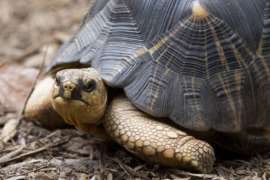Radiated Tortoise
Radiated Tortoise
Radiated tortoises are only native to the island of Madagascar but have been introduced to two other small islands to the east – Réunion and Mauritius. They are named for the yellow lined patterns on their shells. They are herbivores and much of their diet comes from grazing on grasses, which helps keeps plants trimmed back. The illegal pet trade and poaching are major threats, and conservation efforts are underway to save this critically endangered tortoise.
Astrochelys radiata
Herbivore
Madagascar [VIEW MAP]
Dry Forests, Scrublands
In the warmer months, the radiated tortoises can be found outside of Scaly Slimy Spectacular, next to the Aldabra tortoises and inside of the main domed building. In the cooler months, these tortoises will only be in their indoor habitat.
Photos and Videos
The radiated tortoise’s name comes from its appearance. Each of the scutes, the bony plates covered in keratin on their shells, has yellow markings that radiate from the center. The radiated tortoise’s feet, legs and head also have yellow markings. This pattern helps camouflage the tortoises among the leaf litter and thorn scrub shade.
Radiated tortoises can grow up to 15 ½ inches in length and can weigh up to 23 pounds. Those are average numbers, but the largest radiated tortoise on record is a female weighing 55 pounds! Males and females look slightly different, with males having a generally longer tail and a more noticeable notch in the underside of the shell (plastron) below the tail. Radiated tortoises have the typical tortoise body shape, including a high-domed shell and elephant-like feet.
Male radiated tortoises are sexually mature when they are around 12 inches long, and females are typically larger before they sexually mature. It can be 16 to 21 years before they are considered mature and able to reproduce! Females can produce one to three groups of eggs (clutches) per breeding season, with an average of one to five eggs per clutch. A female uses her back legs to dig a nest 6 to 8 inches in the ground, lays her eggs, and after burying the eggs, leaves the nest site. Incubation usually lasts between five and eight months. Hatchlings are a pale-yellow color with black markings and have flatter shells than adults, but the shells will become more dome-shaped as they grow.
Radiated tortoises have long lifespans and have only been in human care in zoo settings since the 1960s, so we need more data to know for sure how long they can live. Based on what we do know, we believe they can live up to 100 years!
In the warmer months, the radiated tortoises can be found outside of Scaly Slimy Spectacular, next to the Aldabra tortoises and inside of the main domed building. In the cooler months, these tortoises will only be in their indoor habitat.
Radiated tortoises live in the extreme southern and southwestern parts of the island of Madagascar and have been introduced to the islands of Réunion and Mauritius.
Their habitat consists of dry, spiny forests and areas with low, irregular rainfall. They are also found on high inland plateaus and sand dunes along the coastline.
A favorite meal in the wild is the Opuntia cactus, an invasive species that is growing rampant in the radiated tortoise’s natural habitat. The tortoises will eat cacti pads, even eating the spines! Radiated tortoises typically graze in the same area, preferring the high-protein, low-fiber content of new growth to the less tasty, mature growth. This keeps plants closely trimmed. In the wild, grazing constitutes 80 to 90 percent of their diet, but they also eat fruits and succulent plants. In the Zoo, they eat a diet of mostly leafy greens with some other produce like squash and carrots mixed in.
In Madagascar, slash-and-burn agriculture and mining have diminished habitat for this now critically endangered tortoise. An estimated 200,000 radiated tortoises are poached from the
wild annually for the illegal pet trade and meat. It is estimated the radiated tortoise could be extinct in just 10 to 20 years due to current threats. Some native groups of people in Madagascar (Mahafaly and Antandroy) who share the habitat with the radiated tortoise have a fady (taboo) against any use of these animals. Conversely, some other groups remove large quantities of radiated tortoises from the wild. The radiated tortoise is considered a flagship species, meaning that conservation efforts for these tortoises will also benefit other species, including plants. Nationally, the radiated tortoise is protected under Malagasy law and internationally protected under CITES Appendix I. You can also help save radiated tortoises by not participating in the illegal pet trade and by discouraging friends and family from doing so.
Zoo Atlanta supports the Turtle Survival Alliance’s Radiated Tortoise Reintroduction Program through the 2019-2020 program year of Quarters for Conservation. In 2018, unprecedented confiscations of over 18,000 radiated tortoises were rescued and are cared for by the Turtle Survival Alliance. The Radiated Tortoise Reintroduction Project’s goal is to reintroduce these poached tortoises back into the wild into safe and suitable habitats with the support and involvement of local people. Zoo Atlanta’s radiated tortoises are also part of the Association of Zoos and Aquariums’ Species Survival Plan® (SSP), which maintains genetic diversity of a species within a zoological population.



